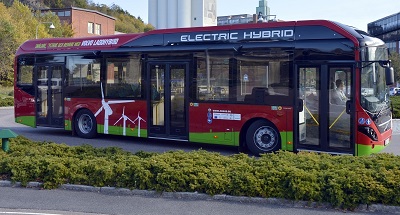Alstom Aptis Electric Urban Mobility – 2017 Busworld Europe
Aptis, an unique urban e-mobility product, has received “Innovation Label” at Busworld Awards this year.
At the 2017 Busworld exhibition in Kortrijk, Belgium, French rail and passenger transport firm Alstom displayed its unique electro-mobility solution for city applications. Inspired from the design and working of trams, the `Aptis´ is an electric city bus-like product, with unconventionality as its basic trait! It has been developed in partnership with NTL.
Also Read: BYD Midibus Battery Electric 8.7m – 2017 Busworld Europe
On the face of it, the Alstom Aptis renders a futuristic low-floor bus concept, but the fully-steerable wheels situated at both the ends of the vehicle with no overhangs makes you look awestruck! This functionality is perhaps the important character that Alstom feels necessary for all city buses in future. The vehicle occupies 25 percent less surface area in curves, can have ridiculously short turning radius in city traffic and BRTS systems, and what not?
The double doors, again derived from tram design, offer easier passenger flows inside and out, quite friendly for wheelchairs and strollers as well. There are panoramic windows at both ends, offering 20 percent more window surface than regular buses. The cabin also experiences low noise levels, claims the company. The passenger compartment can be easily customized to suit unique needs. A lounge at the rear, two or three twin-doors, or customized seating layout – anything is possible with the flexible interior design says Alstom.
Also Read: Sustainable Mobility: A Global Vision In Indian Context
Where are the batteries and power systems located then? Fully low-floor layout must hint you that they are placed up over the roof, with the axle-mounted drive motors powering the wheels. Alstom has also previewed ground-based static charging system `SRS´ for electric vehicles like Aptis, something again inspired from the tramways infrastructure.
The Aptis is presently on trial runs on the Ile de France network, while similar experimentations in other French and European cities are planned in near future. It is manufactured at NTL’s plant in Duppigheim, with key components sourced from Alstom’s facilities in France.
Next, would you like to read more on 2017 Busworld Europe, or Sustainable Mobility?










